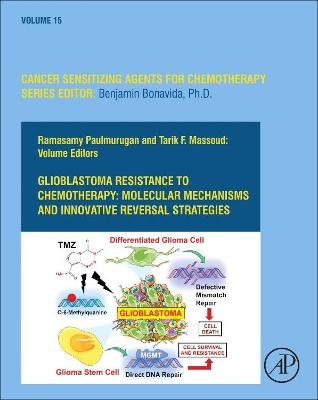
Glioblastoma Resistance to Chemotherapy: Molecular Mechanisms and Innovative Reversal Strategies
Academic Press Inc (Verlag)
978-0-12-821567-8 (ISBN)
Glioblastoma (GBM) is the most invasive and malignant primary brain tumor in humans with poor survival after diagnosis, therefore it is imperative that molecular and cellular mechanisms behind therapy resistant GBM cells, as well as the therapeutic strategies available to counter the resistance are comprehensively understood.
Dr. Paulmurugan has expertise in molecular imaging, pre-clinical cancer imaging, cancer biology, nanotechnology, and molecular biotechnology. Dr. Massoud has expertise in molecular imaging, translational cancer imaging, neuro-oncology, and applications and perspectives relevant to clinical cancer management of glioblastoma patients.
1. Overview of glioblastoma biological hallmarks and molecular pathology
2. Past and present drug treatments for glioblastoma
3. Investigational new drugs against glioblastoma
4. Molecular mechanimsms in temozolomide-resistant glioblastoma
5. Glioma stem cells and associated molecular mechanisms in Glioblastoma
6. Signaling in the tumor microenvironment of therapy-resistant glioblastoma
7. Intratumoral heterogeneity associated with glioblastoma drug response and resistance
8. Role of apoptosis, autophagy, and the unfolded protein response in glioblastoma chemoresistance
9. Role of multidrug resistance in glioblastoma chemoresistance: Focus on ABC transporters
10. Role of mitochondrial reactive oxygen species in glioblastoma drug resistance and strategies for therapeutic interventions
11. Glioblastoma cell-induced immunosuppression causing chemoresistance
12. Role of cell quiescence in glioblastoma cytotoxic resistance and strategies for therapeutic intervention
13. The molecular and cellular effects of radiotherapy-induced microenvironment changes on potential chemoresistance in glioblastoma
14. Molecular and cellular mechanism in recurrent glioblastoma chemoresistance
15. Role of long noncoding RNAs in temozolomide-resistant glioblastoma
16. Mechanisms of glioblastoma resistance to antiangiogenic agents and reversal approaches
17. Treatment and resistance of glioblastoma to CAR T-cell immunotherapies
18. On chip analysis of glioblastoma cell chemoresistance
19. Three-dimensional in vitro models to study potentiation of glioblastoma resistance by hypoxia
20. Chemoresistance mechanisms in mouse models of glioblastoma
21. Therapeutic approaches to overcome temozolomide resistance in glioblastoma
22. Understanding signal transduction pathways to overcome targeted therapy resistance in glioblastoma
23. Targeting the molecular mechanisms of glioma stem cell resistance to chemotherapy
24. Immunotherapy for glioblastoma as a means to overcome resistance to standard therapy
25. Role of microRNA therapy in presensitizing glioblastoma cells to temozolomide treatment
26. Drug penetration through the blood-brain barrier after radiotherapy: New approaches to bypass glioblastoma chemoresistance
27. Nanoparticles beyond the blood-brain barrier for glioblastoma
28. Small molecules targeting misfolded mutants of p53 as a rescue strategy to improve glioblastoma chemotherapy
29. p53 supplementation as a targeted cancer gene therapy for glioblastoma
| Erscheinungsdatum | 21.06.2021 |
|---|---|
| Reihe/Serie | Cancer Sensitizing Agents for Chemotherapy |
| Verlagsort | San Diego |
| Sprache | englisch |
| Maße | 191 x 235 mm |
| Gewicht | 1790 g |
| Themenwelt | Medizin / Pharmazie ► Medizinische Fachgebiete ► Onkologie |
| Naturwissenschaften ► Biologie | |
| ISBN-10 | 0-12-821567-4 / 0128215674 |
| ISBN-13 | 978-0-12-821567-8 / 9780128215678 |
| Zustand | Neuware |
| Haben Sie eine Frage zum Produkt? |
aus dem Bereich


